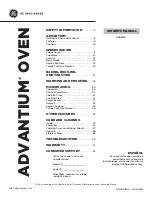
IMPORTANT SAFETY INSTRUCTIONS
18.
23.
19.
20.
24.
21.
25.
22.
26.
27.
28.
29.
In the ½ Time,
Complete Meal
and
Convection
modes
use glass, metal or ceramic utensils which are
“Oven
Safe”
. In the microwave mode use only cooking utensils
and accessories made for use in the microwave oven.
Use aluminum foil only as directed in this book.
Do not
use outdoors.
Do not
pop popcorn in anything other than a
microwave oven popper unless it is a specially treated
bag labeled:
“
Microwave popcorn intended for use in the
microwave”
.
Never
use brown paper bags, glass or plastic bowls, or
other unsuitable containers to pop popcorn. To avoid
scorching and burning, remove popcorn after popping
has slowed to two or three seconds between pops.
Prolonged popping can cause smoking from
overheated oil, breakage of dishes, damage to oven
and eventually a fire.
Do not
remove the outer case or any shields inside the
oven cavity.
Briskly stir liquids or pureed baby food before heating
and reheating to incorporate air. This prevents abrupt
boil overs that sometimes occur after air-depleted
liquids are heated, especially in tall, narrow containers.
Liquids, such as water, coffee, or tea are able to be
overheated beyond the boiling point without appear-
ing to be boiling. Visible bubbling or boiling when the
container is removed from the microwave oven is not
always present. This could result in very hot liquids
Suddenly Boiling Over when the container is disturbed
or a utensil is inserted into the liquid.
Do not
fry or deep fat fry in the microwave oven. Hot
oil can splatter and result in skin burns.
PLASTIC WRAP
:
Use only in the microwave mode. Use
only those types designed for microwave oven use and
avoid forming an air-tight seal. Fold back a small corner
or cut a slit to allow steam to escape. Use pot holders
with plastic wrap-covered utensils.
ALWAYS
use pot-holders when handling dishes or
food in the ½ Time,
Complete Meal
and
Convection
mode.
Stay near the appliance while it is in use and check
cooking progress frequently. Leaving the appliance
unattended may result in overcooked food and a
possible fire in you oven.
When heating a liquid, like soup or beverages, up to a
boiling point, do not take it out of the oven immediate-
ly. Wait 30 seconds before removing to avoid spilling a
hot or scalding liquid.
After heating up baby feeding bottles the content
should be shaken and the liquid temperature should
be checked before feeding, in order to avoid feeding
hot or scalding liquid.
MICROWAVE TIPS TO AVOID OVEN DAMAGE
SAVE THESE INSTRUCTIONS
Do not
operate microwave oven when empty or with empty
utensils.
Never
use sharp-edged utensils in or near the oven.
Use
ALUMINUM FOIL
only as directed in this book or other
special microwave cookbooks. Small strips of foil on meats
are helpful in shielding microwaves to prevent overcooked
areas. Low-sided aluminum foil pans, such as TV dinner
trays, may be used. Use care to keep aluminum foil at least 1
inch away from oven walls, door or top. Metal placed closer
than 1-inch from interior surfaces can cause arcing
(electrical
sparks)
. If arching occurs, stop microwave and remove foil.
PREVENT BURSTING OR EXPLOSION FROM FOOD AND
CONTAINERS
Pierce microwavable plastic bags and pouches for frozen
foods before heating. Pierce foods with heavy skins such as
potatoes, whole squash, apples and chestnuts before cook-
ing. Piercing allows steam to escape and eliminates pressure
build-up.
CONTAINERS WITH RESTRICTED OPENINGS
such as
narrow-necked pop bottles or salad dressing bottles should
never be placed in the microwave for either defrosting
or heating. These can explode, even if the top has been
removed, when heat has built up in the lower portion of the
container.
RAW EGGS IN THE SHELL OR HARD COOKED EGGS
should
never be microwaved. Eggs heat so quickly that pressure
build-up might not be avoided, and an explosion could
occur.
DO NOT USE RECYCLED PAPER PRODUCTS
when
Microwaving. They may contain small metal fragments
which could ignite,
3
Summary of Contents for Half Time Oven 2X
Page 2: ......






































